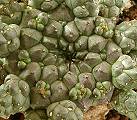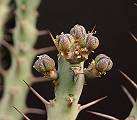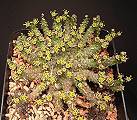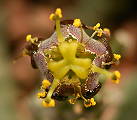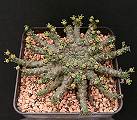|
|
Head of Gorgon Euphorbia gorgonis from South Africa E.gorgonis is a typical
representative of the “medusa heads”. The growth habit of this
group, spherical to cylindrical stem with circular arranged, cylindrical
branches, is unique in the plant world. To have something like that
in your collection is a must. |
|
|
Since all medusa look
somewhat similar, beginners are often confused. Besides shape and dimensions
of the stem, branches and leaves, significant differences occur in the
cyathia. For the identification of the species, form, size and colour of the
mostly conspicuous glands are particularly important. A further distinguishing
character between the species is whether the cyathia stems get woody and
remain on the plant, or whether they wither and fall off. The latter is the
case in E.gorgonis. Like all medusas, E.gorgonis
needs plenty of sun and a harder treatment to keep the compact growth form.
If the branches get long and thin, then the plant is definitely kept too
dark. Flowering period is April to
May (weaker) and July to September (stronger). The cyathia are bi-sexual, for
seed production two clones are required. Germinating the seed is
easy, but the seedlings have the tendency to force each other out of the
substrate with their roots. They have to be thinned out before the sensitive
roots dry up. Propagation by cuttings is
possible. However, the typical growth form only forms from a branch once it
gets beheaded after rooting. Sometimes, in the different species with
variable frequency, the branches form new heads while still on the mother
plant. These are the ideal candidates for cuttings. |
|
|
|
Similar species with the same
cultivation requirements and equally floriferous are - E. crassipes: spherical stem with spreading branches - E. flanaganii: spindle shaped stem with thinner branches,
yellow glands Sources for E. gorgonis: DE: Kakteen-Haage |
||
If you found this page without a left frame
please load www.euphorbia.de
